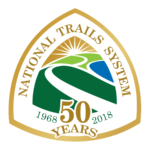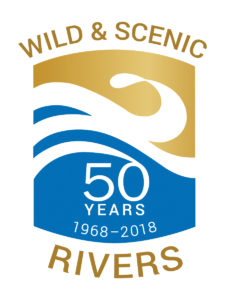by Gary Werner, Executive Director, Partnership for the National Trails System

 We began 2018, the 50th anniversary year of the National Trails System and the Wild and Scenic Rivers System, with an inspiring Congressional Reception during Hike the Hill in February. The reception, held in the Kennedy Caucus Room in the Russell Senate Office Building, was attended by more than 200 organizational and Federal agency leaders, members of Congress, and their staffs. We concluded a year of numerous special events and activities throughout the country with a National Trails System 50th Anniversary Training Conference co-located with the River Management Society’s Wild and Scenic Rivers Symposium in Vancouver, WA in late October. More than 400 rivers and trails activists attended the two events, including 33 youthful Trail Apprentices. It was quite fitting to celebrate these two national linear resource systems together, just as it was appropriate for Congress to authorize them in the same year and for President Lyndon Johnson to sign the laws establishing them at the same time on October 2, 1968.
We began 2018, the 50th anniversary year of the National Trails System and the Wild and Scenic Rivers System, with an inspiring Congressional Reception during Hike the Hill in February. The reception, held in the Kennedy Caucus Room in the Russell Senate Office Building, was attended by more than 200 organizational and Federal agency leaders, members of Congress, and their staffs. We concluded a year of numerous special events and activities throughout the country with a National Trails System 50th Anniversary Training Conference co-located with the River Management Society’s Wild and Scenic Rivers Symposium in Vancouver, WA in late October. More than 400 rivers and trails activists attended the two events, including 33 youthful Trail Apprentices. It was quite fitting to celebrate these two national linear resource systems together, just as it was appropriate for Congress to authorize them in the same year and for President Lyndon Johnson to sign the laws establishing them at the same time on October 2, 1968.
The concept, scope, and reach of each of these linear systems is vast, challenging, and inspiring. The National Trails System is predicated on the radical notion that citizens should be trusted and empowered to be active stewards of major and extensive recreational, educational, and preservation resources—fundamental components of our nation’s natural and cultural heritage.
Collaboration imbues the work we do within the National Trails System. In that spirit, our Federal agency partners and leaders of the Partnership for the National Trails System, American Trails, American Hiking Society, and Rails-to-Trails Conservancy worked all year to disseminate information to the public about the trails, organize and guide special events, and engage the outdoor recreation industry to better support these resources. We also collaborated with the four national organizations, River Management Society, American Rivers, the River Network, and American Whitewater, that support the Wild and Scenic Rivers System.
These two extensive linear systems—rivers and trails—are quintessentially both destinations and the places, the routes for undertaking journeys. Besides preserving critical natural, cultural, scenic, and historic resources, our national rivers and trails also preserve, refresh, and inspire our human spirit. There are hundreds of favorite, special places—destinations—along them. At the same time, both national trails and rivers inspire dreams of journeys, whether brief—a day or less—or lengthy—spanning months or even years. They provide the opportunity, and the locale to live those dreams. The act of going, of traveling through extensive landscapes, is just as valuable and beneficial as arriving at the desired destination.
In these ways our national trails and rivers are major components of what Wallace Stegner called “the geography of hope.” Stegner first used this term in a December 1960 Wilderness Letter to the Outdoor Recreation Resources Review Commission about the report it was preparing to send to Congress (the full letter can be found at www.wilderness.org). He was referring to the value of wilderness and the necessity to preserve it in Alaska and elsewhere in the United States. To Stegner, one of the values of wilderness resided in its mere existence to buoy the spirits of people who would never gaze upon it, let alone travel through it.
For many, our rivers and trails are what tie them—us—to our Mother Earth and inspire our nurturing instincts of stewardship for our Earth and for one another. Whether building new trail tread, planting prairie seeds, clearing space around ancient bur oaks so they can capture sun and wind, telling the stories of past journeys by our long-ago ancestors, or traveling those rivers and trails, we are all partaking of “the geography of hope.” We inhabit that landscape as it resides both in our souls and on the land and water we work to preserve. We expand that landscape, “the geography of hope,” through our work making and sustaining the national scenic and historic trails.
“The geography of hope” is a way of expressing what native Hawaiians, working to revive the Ala Kahakai National Historic Trail as a regularly used way to travel along the shore of Hawaii, once explained to me as the inherent and inseparable link between the people and the land. They said the Hawaiian language did not separate people from the land the way that English does as if we exist outside the nurturing womb of the Earth. “The geography of hope” is both within us and spread across the land as we are inherently creatures of the Earth.
Another way of expressing that essential link is voiced in “The Answer” by the poet Robinson Jeffers: “Integrity is wholeness, the greatest beauty is Organic wholeness, the wholeness of life and things, the divine beauty of the universe. Love that, not man apart from that…” I see that love manifest in the care with which so many citizen volunteers and professional staff sustain our trails and in the care they have for their comrades in stewardship.
With that understanding and in that spirit, let us begin the second half-century of the National Trails System resolved to redouble our efforts to be as inclusive as possible in inviting a diverse population to join us to:
- Close the gaps in our national trails;
- Permanently preserve more of the special places along them;
- More completely interpret the important historic sites along them including the multiple stories and perspectives about the history;
- Help all of our citizens and visitors find their place and way along our national trails.
We have much joyful, good work to do together within “the geography of hope.” Let us “proceed on.”
“We simply need that wild country available to us, even if we never do more than drive to its edge and look in. For it can be a means of reassuring ourselves of our sanity as creatures, a part of the geography of hope.”
– Wallace Stegner, written in his 1960 letter to the Outdoor Recreation Resources Review Commission
Unless otherwise indicated, all material in Pathways Across America is public domain. All views expressed herein are perspectives of individuals working on behalf of the National Trails System and do not necessarily represent the viewpoint of the Federal agencies.